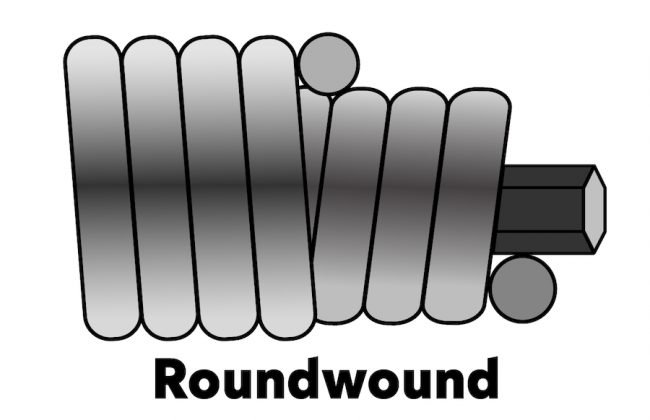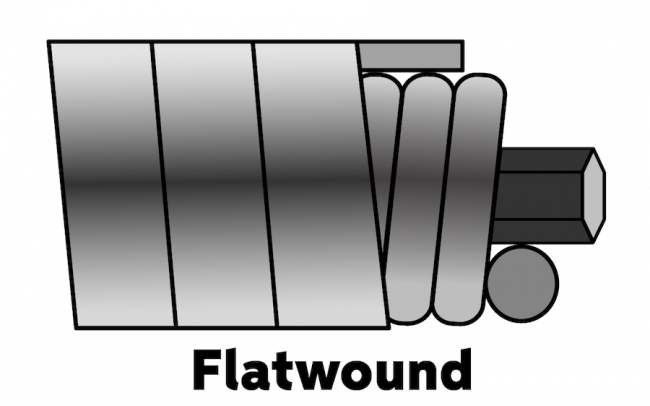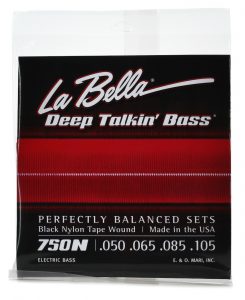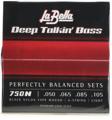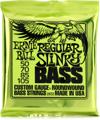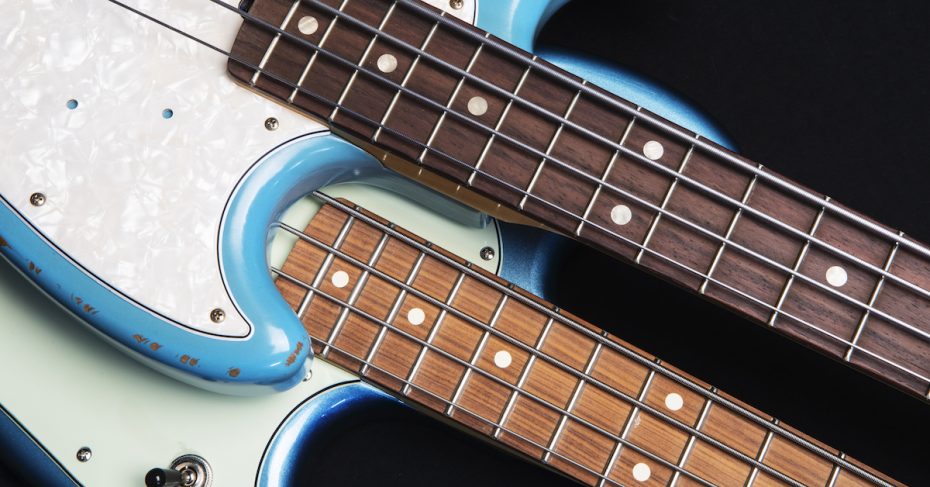
Why would you want to choose flatwound bass strings over roundwound bass strings? Or, perhaps more to the point, when is it worth the relatively high cost (compared to guitar strings) to try out a set of flatwound bass strings? To make an informed decision, let’s examine the differences between flatwound and roundwound strings, both in terms of construction and how they sound. Keep in mind that the majority of this article will apply to flatwound and roundwound guitar strings, too.
- Difference in Construction
- How Do They Feel?
- How About Sound?
- Recording vs. Performing
- Do You Play Bass with Overdrive/Distortion?
- What Are Tapewound Bass Strings?
Differences in Construction
Practically all bass strings are based around two components: a core wire and a wrap wire. The wrap wire is wrapped around the core, and this wrap wire makes up the key difference between flatwound and roundwound strings. For roundwound strings (which most likely came stock on your bass when you bought it), the wrap wire is a round wire, and you can feel the ridges of the individual wraps under your fingers. For flatwound strings, the wrap wire is flattened, and you can barely feel any ridges between the wraps.
What we’ll leave out of this conversation are the myriad options for wire materials, the various string gauges, and all the other variables that aren’t specific to either type of string. For more information on bass strings in general, head over to our Bass Guitar String Buying Guide.
How Do They Feel?
Even before you plug in and play, you’ll notice a big difference between the feel of roundwound strings and the feel of flatwound strings. It’s probably safe to assume that you’ve felt roundwound strings before — as we’ve noted, you can feel the ridges between the wraps of the wrap wire, especially when you’re sliding between notes. With flatwound strings, that friction is mostly absent. The feel of flatwounds is often described as fast and slick — if you’re used to playing roundwounds and switch to flatwounds, you may even find yourself overshooting note slides until you recalibrate for the faster feel.
Obviously, whether one feels better than the other to you is subjective. Some bassists prefer the extra bit of friction that roundwound strings offer, especially if their hands get sweaty while playing. Other players may appreciate the smoother feel of flatwounds, especially when playing over extended periods. Even if you’ve built up your calluses with roundwounds, the faster feel of flatwounds can become addictive.
How About Sound?
Whether you play bass with your fingers or with a pick, roundwound bass strings sound brighter than flatwound bass strings. Roundwounds have a more even balance between low-end thump, midrange character, and high-end detail, relative to flatwounds. Flatwound strings have reduced high end, giving them more emphasis on mids and lows. Bassists playing rock, punk, and pop styles often choose roundwounds for their enhanced presence in a busy mix. For reggae, R&B, and jazz, the smoother, warmer sound of flatwounds is often more appropriate.
Of course, these are just basic examples using some common musical styles. And for the purposes of this article, we’re not going to get into the details of setting up your amp or various pedals — those play a huge role in your tone, too. The idea is that, all other things being equal, roundwound bass strings have a brightness and “zing” that flatwounds don’t have. Said another way, if you often find yourself rolling back your tone control to take that zing out of your roundwound strings, then you may enjoy playing flatwound strings instead.
We recorded a Precision Bass with both roundwound and flatwound strings for our article, “The Great Direct Box Comparison.” You can listen to the differences between the strings by clicking play on the samples below or checking out the entire article.
Recording vs. Performing
Even if you’re happy performing live with roundwound bass strings, having a bass strung with flatwounds ready to go for recording purposes is something worth considering. Recording puts every nuance of your tone under a microscope, so to speak, and noises like finger squeaks are much more apparent. Especially with sparse arrangements and softer musical styles, finger squeaks need to be kept to a minimum. The smooth surface of flatwound strings results in fewer finger squeaks compared to roundwounds.
Do You Play Bass with Overdrive/Distortion?
If you play bass through an overdrive pedal or an overdriven amp, here’s something else to consider: the round wrap wire of roundwound strings causes them to create more harmonic overtones compared to a flatwound string of the same length and string gauge. The tone you’re hearing from your amplifier is a combination of the harmonic content from the signal source (your strings) and the harmonic content generated by your overdrive pedal, tube preamp, and other gain stages. When you play roundwound strings, you’re generating more harmonic content at the source, then adding more harmonics on top of those with your drive. With flatwound strings, you’re relying more on your amp and pedals for harmonic content.
So, what’s the difference? To my ears, an overdriven bass guitar with flatwounds sounds fuller and purer than an overdriven bass with roundwounds on it. This is highly subjective territory, and it’s one of the best reasons I can think of to experiment with flatwound strings. You’ll need to set your amp and pedals a bit brighter — and possibly turn up the gain a bit, too — to match the relative brightness of roundwound strings, but the resulting overdrive tone may sound much closer to your ideal sound. You’ll never know until you try it!
What Are Tapewound Bass Strings?
Tapewound bass strings are technically flatwound strings in terms of construction. Instead of a flattened metal wrap wire, however, the wrap wire is composed of a nonmetal material such as nylon. The tone is even more mellow and fundamental than flatwound strings with a metal wrap wire, almost entering rubber band territory. The feel is amazingly fast and slick, perhaps even more so than metal flatwound strings. It’s not the most versatile sound but may just be the ticket for dub, soul, hip-hop, and other styles that call for ultra-warm bass tone. Another bonus for some players is that tapewound strings won’t corrode the way that metal-wrapped strings do, which gives them a longer lifespan. Check out our collection of tapewound bass strings.
What’s the Best Set of Flatwound Strings to Try?
That’s definitely going to depend on whether you play a long-scale or short-scale bass, how many strings it has, and what your preferred string gauges are. Lucky for you, Sweetwater Sales Engineers are experts at matching strings to instruments — give them a call at (800) 222-4700 for some help finding new bass string sets to try out. Or just check out all of our flatwound bass string options.


